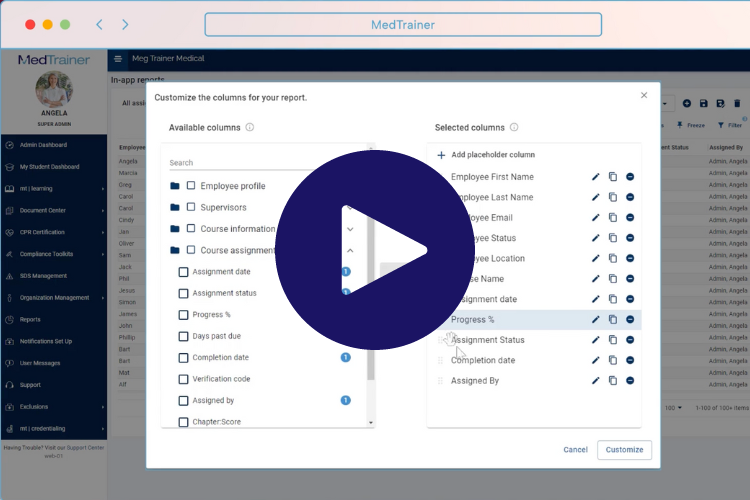Compliance is a major focal point for every healthcare organization. Whether it’s compliance with HIPAA standards, OSHA workplace regulations, or simply adherence to established best practices, compliance is synonymous with excellence. But, to become (and stay) compliant, organizations need to make an ongoing commitment to healthcare compliance training for their staff.
With so many standards and practices to consider and staff spanning a wide range of disciplines, locations, and areas of expertise, healthcare compliance training is often easier said than done. Thankfully, there are emerging technologies that are making it easier for organizations to set the bar high for themselves and their people.
Download a free template to design an effective compliance training program.
What Is Compliance Training?
As a quick refresher, compliance training is healthcare training offered to employees as a way to educate them about state and federal laws, regulations, and rules regarding their work. Often, compliance training for healthcare staff must be completed according to a specific timeline — annually for OSHA and HIPAA training, for instance.
Additionally, the progress and results from compliance training need to be monitored and tracked, to ensure there’s a clear record of completion if and when your facility is audited for compliance. Proof of completion and demonstration of competence represent your organization’s commitment to excellence across best practices, ethics, and safety standards.
Why Is Compliance Training Important?
Why go through all the trouble of setting up and managing a robust compliance training program? Well, the simplest answer is because healthcare organizations need to — it’s quite literally the law!
Outside of the mandated aspect of annual HIPAA and OSHA trainings, however, there are plenty of reasons why organizations should want a great training program:
- Compliance training ensures consistent, quality patient care
- Proper compliance can help organizations avoid fines and legal action
- Organizations save time and money by standardizing education and learning
- Compliance training creates accountability across the entire staff
- Training empowers staff to feel knowledgeable and confident at work
- Proof of diligent compliance training shows a commitment to excellence
Ultimately, respect for compliance training sets an organization-wide tone for everyone. Professionals want to work in an environment where they’re held to clear and well-understood standards. Patients want to receive care from an organization that cares about the delivery of that care. Even regulators take comfort in knowing that the standards they’re in charge of setting are raising the bar for success!
Popular Compliance Training Examples
Compliance training isn’t limited to any one specific area of healthcare delivery or administration. In fact, compliance standards reach across organizations and come with their own best practices and minimum standards. Some popular compliance training topics include the following:
- Anti-harassment
- Business ethics
- Corporate compliance
- Cybersecurity
- Data protection and privacy
- Diversity and inclusion
- Health Information Portability and Accountability Act (HIPAA)
- HR compliance
- Information security
- Insurance
- International Organization for Standardization
- Manual handling
- Occupational Health and Safety (OSHA)
- Risk management
- Sarbanes-Oxley Act
- Sexual harassment
- Social media and texting compliance
- Workplace safety
- Workplace violence prevention
Each compliance training example serves a specific purpose: to educate healthcare employees about the rules and regulations regarding that specific practice.
Learning about HIPAA helps healthcare employees to understand patient rights regarding privacy and security. Learning about diversity and inclusion educates healthcare employees about treating everyone equally, despite differences. Workplace safety compliance teaches employees the rules they must follow to ensure safety not only for themselves but also for their work associates and patients. Each course teaches a different subject which further promotes a compliant workplace environment.
What Are the Benefits of Using Compliance Training Software?
Most healthcare organizations have a piecemeal approach to compliance training — one that involves disparate channels, resources, and timelines. For instance, some organizations rely on YouTube videos and seminars to educate their employees. Others might use a more robust learning management system (LMS) to organize and assign online compliance training courses.
Digital LMS systems are becoming more common and accessible, largely because they’re the full package. They offer customization and control for assigning courses to employees, progress tracking and monitoring, digital recordkeeping, updateable materials, and much, much more:
- Allow organizations to track and monitor training progress
- Easy access to various courses in a cloud-native platform
- Keeps employees up to date with new, evolving information
- Reinforces learning with assessments and retraining
- Less time spent searching for reputable training materials
Within a cloud-based LMS framework, there are also incredible opportunities for how to deliver compliance training. Instead of watching a video or reading a memo, digital training materials come with the benefit of a multimedia experience. This makes it easier to break down compliance training into critical segments across various formats, to unlock a whole-new level of value for learners:
- Microlearning provides a quick and effective method to train staff on what they must know, and allows complex regulations to be broken into digestible chunks and customized for specific job responsibilities.
- Skills-based learning focuses on one topic at a time, to demonstrate a best-practice and/or evidence-based approach that allows the learner to test their skills in a case-study environment.
- Scenario-based learning can give learners an immersive approach that uses real-life situations and provides a relatable and highly relevant learning experience. Think of it as watching an example, then doing it yourself.
- Compliance training through gamification, to promote scoring (rewards for correct answers), competition among peers, and engagement. This approach to compliance training can spark interest and intent when it comes to upskilling and education.
Ultimately, digital compliance training works to engage the learner. It’s not just about giving them the information; it’s about ingraining it within them in a meaningful way and in the best way for them to retain and rely on that knowledge.

